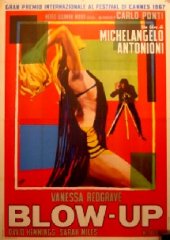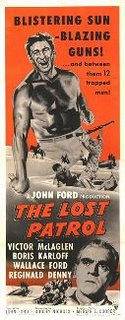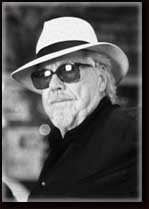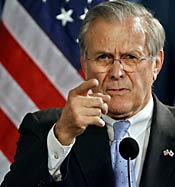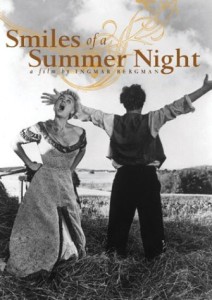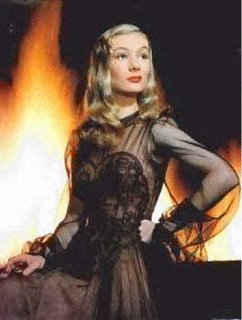
In 1956, Marilyn Monroe married Arthur Miller, the hydrogen bomb and Elvis Presley exploded for the first time and both Tom Hanks and Mel Gibson were born, "In God We Trust" became the US National Motto and The Wizard Of Oz was shown on television for the first time. As always, previous years' results and various disclaimers and methodologies can be found on
The Big List.
11.
Beyond A Reasonable Doubt - I reviewed this mediocre Fritz Lang film
here. Dana Andrews (Laura, Ball Of Fire) stars as a journalist who gets himself arrest for a murder he didn't commit in order to prove the unreliability of circumstantial evidence. Joan Fontaine plays his rich girlfriend who tries to prove his innocence after her father (the one guy who knew about his plan and had his exculpatory evidence) dies in a silly plot twist. The plot gets even sillier and twistier at the end, but I won't give away exactly how. The schematic and didactic nature of the story undermine any kind of emotional interest the viewer might have, and since Lang admittedly hated the film, I don't suspect he made up for it with his direction, but I'm far from a Lang expert (I still haven't seen Metropolis, for one thing).
10.
The Ten Commandments - Cecil B. DeMille's archetypal epic stars Charlton Heston as Moses and follows his efforts to free the Hebrews from slavery in Egypt. Blissfully ignorant of history, the film features Yul Brenner as the pharaoh Ramses II, along with Edward G. Robinson, Anne Baxter, Cedric Hardwicke, John Derek and Vincent Price (of course!). While the famous parting of the Red Sea special effect is admittedly magnificent, the rest of the film can only be described as cheesy. At best, there's a certain camp magnificence to it all, and you have to admire DeMille's dedication to putting his singular vision on the screen. He's like Ed Wood with a massive budget and more conventional neuroses.

9.
Baby Doll - This Elia Kazan adaption of two Tennessee Williams plays (Williams also wrote the screenplay) lacks the appeal of Kazan's greatest films, largely, I think, because it doesn't have the star power of On The Waterfront, East Of Eden or A Streetcar Named Desire. The three actors in this film are pretty good, but are totally lacking in the kind of charisma that neither Brando or James Dean could ever get away from. Karl Malden plays a cotton gin owner with a child bride he hasn't had sex with yet (she's 19 in the movie, about to turn 20, I suspect she's younger in the original). After he burns down a rival's gin, said rival, an Italian played by Eli Wallach (terrific in his film debut), seduces his wife. The actors are all good, but the movie feels overly theatrical, though it does succeed on those rather limited terms.
8.
The King And I - The second Yul Brenner film on the list thus far has his iconic performance as the stuffy King Of Siam whose life is brightened a bit by a unrequited love for an English nanny, played by Deborah Kerr. This is my favorite of all the Rogers and Hammerstein musicals, though that's not really saying much. The reason is essentially Kerr and Brenner, though the "Shall We Dance" sequence is as good as anything in film musicals. Based on a true story, and filmed two other times (most recently in the fine Jodie Foster/Chow Yun-fat film Anna And The King (#41, 1999), there's a great film waiting to be made out of this story, but it hasn't happened yet. Maybe some enterprising Thai director will take a stab at it. Wouldn't you pa to see Pen-ek Ratanaruang's Anna & The King starring Cate Blanchett and Tony Jaa?

7.
Giant - George Stevens's adaptation of Edna Ferber's epic novel, this film is long, rather boring and features some truly terrible performances from Rock Hudson and Elizabeth Taylor. But it also stars James Dean, and every time he's on screen, the film comes alive in a way that few films of the 50s can match. Hudson plays a Texas rancher who picks up a hot young bride (Taylor) while buying horses in Kentucky. He brings her back home where she fights with Hudson's lesbian sister (Mercedes McCambridge, naturally). She also catches the eye of a young neighboring ranch worker (Dean) who makes no secret of his covetousness of both Hudson's wife and his wealth. Convinced there's oil on his small patch of land, Dean eventually strikes it rich (in the film's one truly great sequence). Eventually Dean's rivalry with Hudson extends to the next generation, 20 years later, when Hudson's son, Dennis Hopper, tries to beat him up. Director George Stevens, generally a fine filmmaker (Gunga Din, Swing Time, Woman Of The Year are a few of his several classics), seems to have arrived, at this point in his career, at a style where bombast and melodrama overwhelm any kind of subtlety of expression. His last few films (A Place In The Sun, Shane, Giant, The Diary Of Anne Frank, The Greatest Story Ever Told) all appear to suffer from this defect.
6.
Invasion Of The Body Snatchers - Don Siegel's classic of 1950s paranoia stars Kevin McCarthy (UHF, Innerspace) as a small-town doctor who sees all his friends and neighbors replaced by Pod People. Generally seen as anti-Communist, the film's allegory is far too generic to draw such a specific ideological conclusion. The Pod People can be Communists, or anti-Communists, or victims of Consumerism or Suburbanization, or whatever. They represent the subversion of the individual will to an emotionless automata subject to the will of a collective. The film is simply anti-authoritarian, whether the authority lies on the right or the left. As drama, however, it's somewhat lacking. The actor's aren't especially good, though McCarthey isn't terrible. But the cleverness of the scenario is much greater than the actual experience of the film, which takes a long time to get going, and even when it does, has little to differentiate it self from any other noirish sci-fi thriller of the era. Still, the solid direction by Siegel and the undoubtedly fascinating allegory do enough to move it to the top of any list of the era's science-fiction.
5.
The Wrong Man - A generally underrated and overlooked film from Alfred Hitchcock. Henry Fonda plays a musician wrongly accused of holding up an insurance office. He's arrested, indicted and put on trial, and it's all going quite badly for him. Not only is he certain to go to prison, but the whole ordeal drives his wife, Vera Miles, insane. However, in an ending that's either entirely out of place, false, and tacked on or profoundly moving and spiritual, things all somehow work out. An odd film that seems to stand out from Hitchcock's more famous films, but has a lot in common stylistically and thematically with another one of his overlooked films, I Confess. Both films overtly deal with religious issues, in a way that doesn't fit in with the dominant theory of Hitchcock, that of the perverted voyeur with a thing for blondes.

4.
Written On The Wind - A great Douglas Sirk melodrama which I wrote about a couple weeks ago. Rock Hudson, who I normally can't stand, stars with Lauren Bacall and Robert Stack. Hudson's the poor, moral, friend of Stack's rich alcoholic. Both of them love Bacall, but she marries Stack. Stack's sister loves Hudson, but isn't good enough for him. Everything about the film is outsized, unrealistic and hyperbolic: the vibrant Technicolors, sweeping camera movements, hysterical acting, and every scene is charged with emotion. I need to see more Sirk.
3.
Seven Men From Now - Budd Boetticher made a series of low-budget Westerns with Randolph Scott in the 50s, most of which don't seem to be on DVD, or at least I haven't seen any of them yet. Combing the dark psychology of Anthony Mann's Jimmy Stewart Westerns with the broad landscapes of John Ford, this revenge movie is generally considered one of the best Westerns ever. Scott is fine as an ex-sheriff hunting down the seven men responsible for his wife's death, but he can't really compare to Stewart or Wayne, two of the best actors in Hollywood history.
2.
The Killing - Stanley Kubrick's breakthrough film is this film noir-caper film starring Sterling Hayden as the leader of a gang of crooks out to rob a race track in broad daylight. Things go wrong when Elisha Cook Jr's wife, Marie Windsor (Force Of Evil, The Narrow Margin), a femme fatale whose evil is rivaled only by her annoying stupidity, gets her
boyfriend to try to hold up the crooks. Innovative in the way it plays with time, replaying the various elements of the heist from the perspective of the individual perpetrators, the action is as meticulously detailed and planned in advance as the village defense in Seven Samurai. It doesn't have the throw everything against the wall and see what sticks freewheelin' visual flair of Kubrick's previous film, nor does it have the misanthropic restraint of some of his later work. Like Spartacus, it's Kubrick demonstrating his mastery of a genre more than being his own kind of idiosyncratic genius.

1.
The Searchers - By consensus, the greatest of all John Wayne films, John Ford films, Westerns and one of the greatest films of all time. I can't really argue with any of that. The opening shot, moving through the door of a pioneer ranch house out into a vast Monument Valley landscape, and the final shot, going back through that same doorway, closing Wayne out of civilization and leaving him alone in the wilderness, are pretty much the greatest bookends in film history: profound, beautiful and moving, In between is an intense revenge quest, as Wayne's Ethan Edwards hunts down the Indians that kidnapped his daughter. Much is made of the racism of Wayne's character and Ford and Wayne's opinion of that racism. Less is made of the other narrative thread of the film, the goings on at home while Wayne and Jeffery Hunter are out searching. These scenes, often played for laughs, are an essential counterpoint to the paranoid anti-miscegenation quest. Westerns in general, and Ford's Westerns in particular are about the transition from chaos to civilization, about that middle stage where the two coexist, how one is both essential and anathema to the other. The Searchers puts this dichotomy into high relief. Edwards is essential to civilization, they can't fight the chaos without a warrior like him. But he doesn't fit in civilization, he is the vehicle of his own obsolescence.
Lots of really good Unseen Movies I haven't seen from this year, including works by Ozu, Mizoguchi, Bresson, Tashlin, Renoir, Ichikawa and Minnelli.
Early Spring
Street Of Shame

A Man Escpaed
The Girl Can't Help It
Elena Et Les Hommes
Toute La Memoire Du Monde
Tea And Sympathy
The Burmese Harp
The Red Balloon
. . . And God Created Woman
Forbidden Planet
The Man Who Knew Too Much
Around The World In 80 Days
Moby Dick
High Society
Lust For Life
Samurai III
The Conquerer
The Man In The Grey Flannel Suit
Bigger Than Life
Bhowani Junction
While The City Sleeps
The Eddy Duchin Story
 This is very premature for me, as the size of my Unseen Movies list will indicate, but it's New Year's Eve and everyone else has written their Top Ten list, usually without bothering to note what they have and haven't seen anyway (there's even a section of the blogosphere that seems to have just discovered that Unseen movies should be an essential part of every movie list). So, I figure I might as well throw mine onto the pile. For the purposes of this post only, I'm including films from non-2006 years as listed by imdb, which assigns a film a year based on the first time the movie actually planned. For everything else, I use imdb because I don't believe a film only begins to exist when it plays at the theatre in the US, or even for provincially, when it happens to play in the city I live in. But since the whole reason is to get a list in when all the other lists come out, so some sort of comparison can be made, I figure I should include all the same films every other critic in America uses. Such films will be denoted by an *, and will not be included in 2006 on The Big List.
This is very premature for me, as the size of my Unseen Movies list will indicate, but it's New Year's Eve and everyone else has written their Top Ten list, usually without bothering to note what they have and haven't seen anyway (there's even a section of the blogosphere that seems to have just discovered that Unseen movies should be an essential part of every movie list). So, I figure I might as well throw mine onto the pile. For the purposes of this post only, I'm including films from non-2006 years as listed by imdb, which assigns a film a year based on the first time the movie actually planned. For everything else, I use imdb because I don't believe a film only begins to exist when it plays at the theatre in the US, or even for provincially, when it happens to play in the city I live in. But since the whole reason is to get a list in when all the other lists come out, so some sort of comparison can be made, I figure I should include all the same films every other critic in America uses. Such films will be denoted by an *, and will not be included in 2006 on The Big List. 1. Three Times*
1. Three Times*  Still Life
Still Life 















.jpg)





